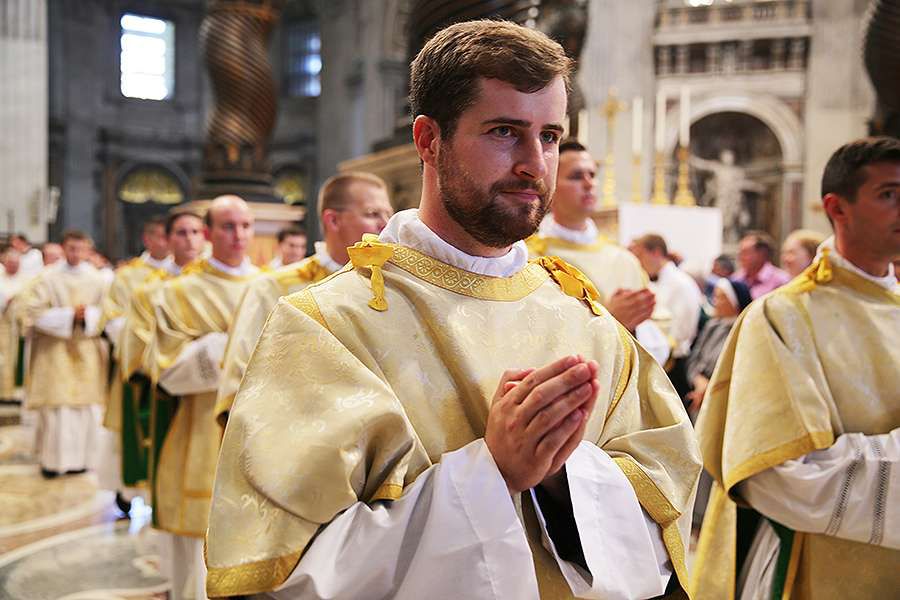Washington D.C., May 26, 2017 / 06:04 am (CNA/EWTN News).- Members of the newest priestly ordination class in the United States were closely connected to the Church growing up through their Catholic school or parish, according to a new survey of the 2017 ordinands.
“They’re much more likely than Catholics in general to have attended Catholic school. A third of them have a relative who’s a priest or religious. They come from pretty active Catholic families,” Dr. Mary L. Gautier, co-author of “The Class of 2017: Survey of Ordinands to the Priesthood,” told CNA. “They have more opportunity to be aware of and around priests,” she added.
The annual survey of ordinands is conducted by the Center for Applied Research in the Apostolate at Georgetown University (CARA). This year’s survey featured 444 respondents, 343 of whom are entering the diocesan priesthood, from 140 dioceses. 101 of the respondents are entering the religious priesthood. The survey was conducted in March 2017. According to the U.S. bishops’ conference, CARA compiles data every year for the Secretariat for Clergy, Consecrated Life and Vocations.
The average age of ordination has continued a slight, yet steady downward trend in age from 1999, as the 2017 class average was 34 years, down from 36 years in 1999. 16 was the average age the ordinands first began considering the priesthood. Most of this year’s ordinands — 82 percent — were “encouraged to consider the priesthood by someone in their life,” most often by a parish priest, although others reported being encouraged by a friend, family member, parent, teacher, or parishoner.
That “staggering number” should spur the faithful to be aware of their role in encouraging vocations, Cardinal Joseph W. Tobin of Newark, chair of the bishops’ Committee on Clergy, Consecrated Life and Vocations, stated in response to the survey. “That statistic should motivate all the faithful to be sensitive to the work of the Holy Spirit, who may wish to use them to extend the invitation to ordained ministry,” he said.
Conversely, almost half the respondents (48 percent), including 60 percent of those in religious life, reported being dissuaded from entering the seminary by someone else. Encouragement of young men to enter the seminary is indeed a “very important” factor in their decision, Gautier said, encouragement “from family, friends, the parish priest, the teachers in the school, all of that makes a difference.
Seminarians were more likely than the average Catholic child to be involved in their parish and attend Catholic school, according to several statistics taken together. “Between 40 and 50 percent” of the respondents went to Catholic school at some point in their life — anywhere from kindergarten through tertiary education -- and almost six in ten (59 percent) received religious education at their parish, “for seven years, on average,” the study said.
They were much more likely than the average Catholic adult to attend Catholic school, especially as they grew older. Half of respondents attended Catholic grade school (K-8), 11 percentage points higher than the national average of 38 percent among adult Catholics. 41 percent of respondents attended a Catholic high school compared to the national average of just 19 percent, and 40 percent attended a Catholic college, much higher than the national average of 10 percent among adult Catholics.
Many ordinands were involved in their parish, either in their prayer life and/or through ministries. Three-fourths were altar servers at their parish, and 52 percent of respondents served as lectors at Mass. 43 percent were Extraordinary Ministers of Holy Communion. Almost four in five regularly prayed at Eucharistic Adoration and almost seven in ten prayed the rosary. And many were involved in group prayer, as almost half attended a regular prayer group or Bible study. Almost half “participated in parish youth groups,” and 34 percent were part of Catholic campus ministry or a Newman Center in college.
Regarding family life, the ordinands had an average of three siblings in their family, and are “very unlikely to be only children,” Gautier said. They are often the oldest siblings in their family, but in 2017 more respondents were middle children than were oldest children in their families.
Demographically, the class did not reflect an increasingly large Hispanic Catholic population in the U.S., and this is a challenge for vocations directors, Gautier acknowledged. Seven in ten respondents were Caucasian, while only one-fourth were foreign-born. Meanwhile, the Hispanic Catholic population is growing, making up 34 percent of the overall Catholic population in the U.S. and 46 percent of Catholic Millennials, according to Pew Research in 2015.
“I think vocation directors are aware of the challenge and are actively working to increase vocations in the Hispanic community, but it’s not reflected in the numbers of ordinands, at least this year,” Gautier explained. 43 percent of the respondents listed an undergraduate degree from a college or university as their highest education level before entering seminary, and 16 percent said a graduate degree was their highest level. Those in religious life were on average more highly educated, as the vast majority (86 percent) of respondents in religious life had received an undergraduate or a graduate degree, compared to 52 percent of diocesan ordinands.
Almost one third (28 percent) of the respondents “carried educational debt, which averaged $28,318, at the time they entered the seminary,” the study showed. Of those who carried such debt into seminary, they “were able to reduce it to an average amount of $25,830 which is 9 percent less than when they entered (unadjusted for inflation),” the study showed. Respondents who were in religious life were actually able to reduce their student debt by almost half (46 percent) while in seminary, as almost three-fourths of them received assistance for this from their religious community. Meanwhile, the average debt for seminarians preparing for diocesan priesthood increased slightly.

